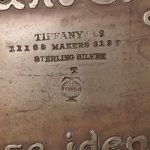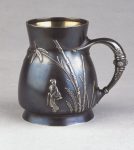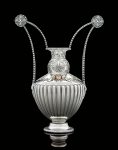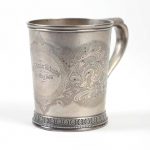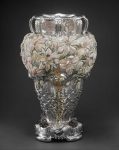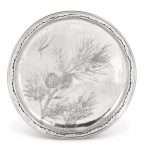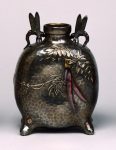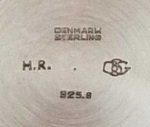Tiffany & Co was founded in New York in 1837 by Charles Lewis Tiffany, initially as stationery and fancy goods store on Broadway, styled Tiffany & Young 1837-1841, when it became Tiffany, Young & Ellis till 1853, when Charles Lewis Tiffany took complete control of the firm, and it was designated Tiffany & Co. From about 1848, Tiffany began to focus on silver and precious stones, controlling their own silver manufacturing shop from 1851. By 1877 they had acquired the Tiffany diamond, a large yellow stone from the Kimberley Mines in South Africa and in 1887, they acquired major pieces at the sale of the French Crown Jewels in Paris. They moved to Fifth Avenue in 1905 and to their present address, Fifth Avenue and 57th street, in 1940.
Tiffany & Co. sold other manufacturers’ flatware until 1869, when they began making their own flatware. Before this date, flatware retailed by Tiffany bears both the Tiffany stamp and the maker’s stamp as a silver retailer and manufacturer. Reference: The British Museum
Tiffany and Co silver makers mark circa 1860
Tiffany and Co silver makers mark circal 1893
TIFFANY: A late-19th century silver vase by Tiffany & Co, Edward Moore period, stamped TIFFANY & VO, STERLING SILVER, pattern number for 1875, pattern and order numbers 3567 – 6438 In the ‘Japanesque’ style, with applied fish swimming amongst water lilies above a frieze of stylised ripples and flowers, a fly landing on the shoulder, oblivious to the dangers below, height 19.5cm, weight 9.5oz.
Sold for £ 3,500 inc. premium at Bonhams in 2018
Tankard; silver and oxidised silver, in the Japanese taste, decorated with applied silver motifs of figures, bamboo and other plants, the background oxidised to a deep grey-black colour; the handle with classical-style palmettes. Tiffany & Co Date 1874-1876 (made;circa)
Reference: © The Trustees of the British Museum
1900 PARIS EXPOSITION UNIVERSELLE: AN AMERICAN SILVER AND ENAMEL “POMPEIAN” VASE MARK OF TIFFANY & CO., NEW YORK, 1900, DESIGNED BY PAULDING FARNHAM On spreading circular base with gadrooned rim, rising to a amphora-form body chased with lobes spaced by reeded arches, the shoulders enameled with stylized red lyres and yellow flowers above scrolling green foliage, neck chased with shells and flowering vines, the upswung openwork handles cast with climbing vines and terminating in two swan heads, the handles topped by stylized pierced rosettes, marked on underside, numbered 13899-1120 and with 1900 Paris Exposition mark 18 ½ in. (47 cm.) high 98 oz. 16 dwt. (3,073 gr.)
Sold for USD 31,250 at Christies in 2019
Tiffany & Co. Sterling Silver Vine Pattern Ice Cream Server Grapevine motif. Length 10 7/8 inches, approximately 4 ounces.
Sold for $375 (includes buyer’s premium) at Doyle New York in 2019
EARLY TIFFANY & CO STERLING SILVER MUG. Circa 1865, bright cut engraved cartouche incised with name “Henry Baker Dickinson, 25th May 1868”; underside with Tiffany & Co., makers marks for Bogert, Newburg, NY; 7.3 ozt h. 4 w. 5 in.
Sold for $800 at Butterscotch Auction in 2019
The Magnolia Vase,ca. 1893 Manufactured by Tiffany & Co. The Magnolia Vase was the centerpiece of Tiffany & Co.’s display at the 1893 World’s Columbian Exposition in Chicago—a display Godey’s Magazine described as “the greatest exhibit in point of artistic beauty and intrinsic value, that any individual firm has ever shown.” The design of the vase was a self-conscious expression of national pride. Pueblo pottery inspired the form, while Toltec motifs embellish the handles. The vegetal ornament refers to various regions of the United States: pinecones and needles symbolize the North and East; magnolias, the South and West; and cacti, the Southwest. Representing the country as a whole is the ubiquitous goldenrod, fashioned from gold mined in the United States. The exceptional craftsmanship and innovative techniques manifested in the vase—particularly the naturalism of the enameled magnolias—were much discussed in the contemporary press. Indeed, the work was heralded by the editor of the New York Sun as “one of the most remarkable specimens of the silversmith . . . art that has ever been produced anywhere.”
Reference: The Metropolitan Museum of Art
Pitcher 1875 Tiffany & Co. (American, active 1837–present)
This silver vessel with copper inlay has a tapering quatrefoil cross section. An acute triangular spout interrupts the uppermost band, which is unadorned. The bottom has incised vertical ribs, intersected by a die-rolled band of stylized flowers. Alternating bands of silver with chased floral decorations and bands of copper inlaid with silver chevrons or circles terminate with a thin band of chased waves and stylized egg-and-dart molding just below the uppermost plain silver band. It has an applied foot and S-scroll hollow cast handle; the interior shows traces of gilding. Acquired at the 1876 Centennial Exposition, this pitcher represents Tiffany’s new line of chromatically decorated silver utilizing mixed-metal techniques. It became the first piece of American silver to enter the Museum’s collection and distinguished the institution for its early interest in contemporary, as well as historic, art. Former Boston jeweler Gideon F. T. Reed, who was then a major shareholder in Tiffany & Co. and head of its Paris office, engaged Frank Hill Smith to select and acquire metalwork for the Museum from the Philadelphia fair. Despite an acknowledged conflict of interest, this pitcher became the first piece of Tiffany silver to enter a museum collection.
Reference: Museum of Applied Art and Sciences
AN AMERICAN SILVER TRAY, TIFFANY & CO., NEW YORK, CIRCA 1881 Japanese-style, spot-hammered surface etched with pine branch and pine cones marked on base and numbered 6492-3615 diameter 12 in. 30.5 cm 26 oz 10 dwt 827 g
Sold for 7,500 USD at Sothebys in 2019
This vase with dragonfly handles and raised clematis vine motifs is rendered in silver with a “martelé” (hammered) surface and is decorated with colored metal encrustations. This combination of techniques recalls the work of Japanese craftsmen who once specialized in the production of swords and sword accessories. After visiting the Japanese display at the Paris Exposition Universelle of 1867, Edward Chandler Moore (1827-91), Tiffany’s master silversmith, became a leading proponent of “Japonisme.”
Reference: The Walters Art Museum

